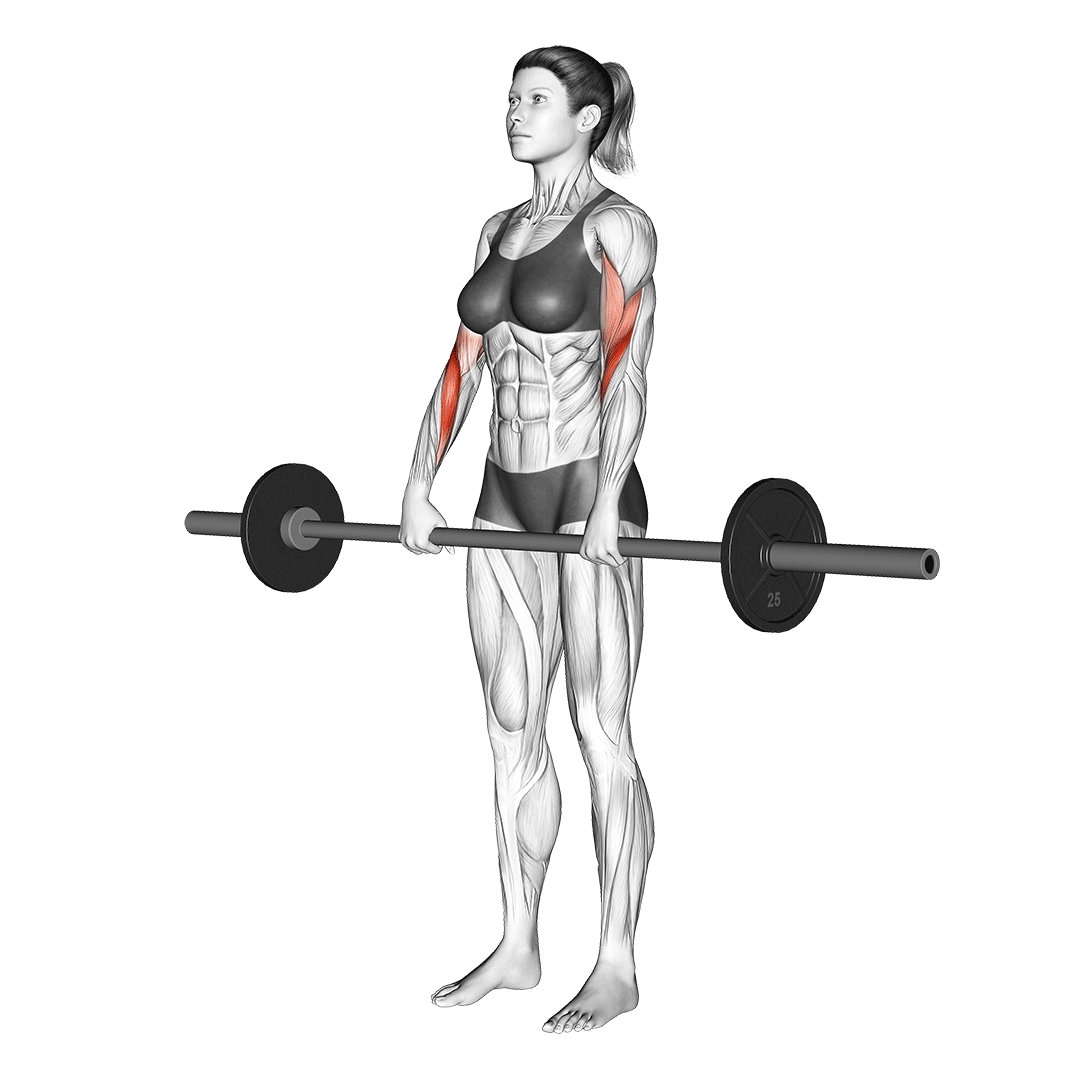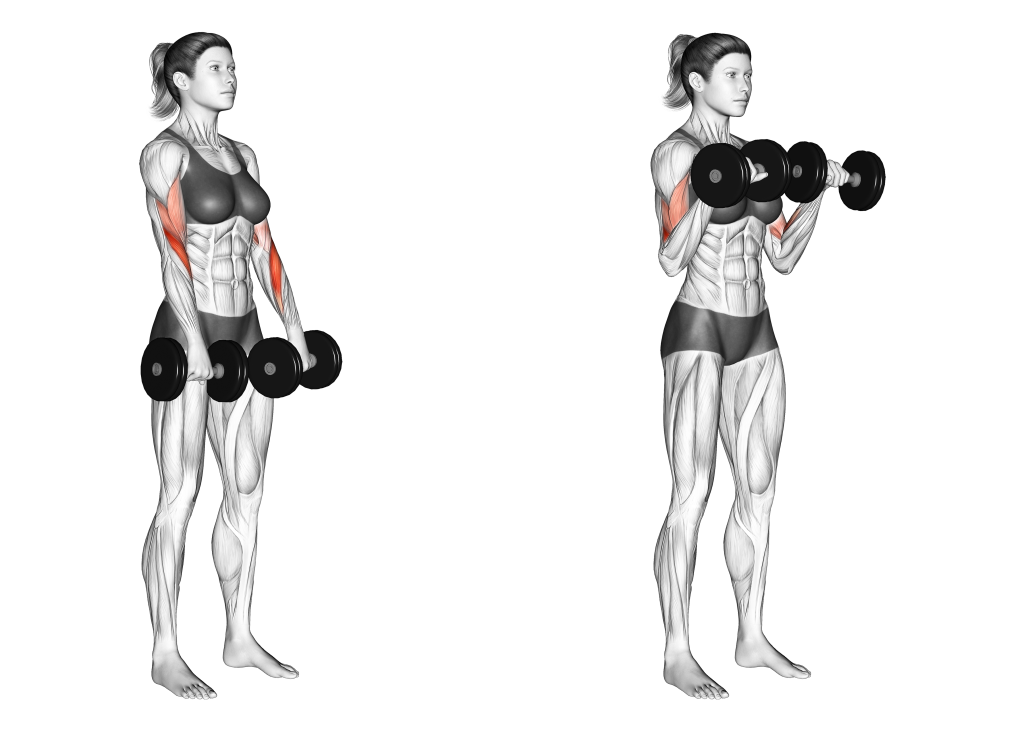Reverse Curls: Benefits, Muscles Worked, and More
Though criminally underrated, reverse curls are an excellent curl variation that add an additional layer of depth to what would otherwise be a simple biceps isolation movement.
By including more muscle groups into the recruitment pattern and altering the lifter’s grip so as to create a more natural movement, the reverse curl is capable of creating benefits that are unlikely to be encountered when performing any other supinated-grip curl exercise.
Reverse curls are a bicep curl variation performed with the weights held in a pronated grip, thereby causing other muscle groups to be recruited, as well as altering the mechanics of the exercise for greater comfort and force-output.
What are Reverse Curls?
Reverse curls are a single-joint free weight compound exercise primarily performed to build muscular strength and size in the arms.

Though they are relatively uncommon, bodybuilding training programs and strongman athlete programs occasionally will include reverse curls so as to increase general arm thickness and grip strength.
Equipment Needed to Reverse Curl
Reverse curls may be performed with any number of different free weight implements, but are most effective when performed with a pair of dumbbells or with an EZ-barbell, as the usage of a straight barbell may place strain on parts of the wrists and forearms.
How to Do Reverse Curls
To perform a repetition of reverse curls, the lifter will stand upright with both hands gripping the weights in a pronated fashion.
The elbows and upper arms should remain relatively stationary at the sides of the ribcage, and each repetition should begin with the weights hanging around the pelvis for a full range of motion.
Once set up correctly, the lifter will bend at the elbows and draw the weights upwards, stopping once the hands are at approximately shoulder-level elevation.
Squeezing their biceps and forearms in this position, they will then reverse the motion in a slow and controlled manner, stopping once the weights have returned to their original spot near the pelvis.
What Muscles are Worked by Reverse Curls?
Reverse curls are a compound exercise, meaning that they train more than a single muscle group in an active fashion.

This is achieved - just like with other curl variations - through the usage of the elbow flexion biomechanic, though the pronated grip of the reverse curl also targets parts of the forearms in a dynamic manner as well.
Primary Mover Muscles
The main muscle groups worked by the reverse curl are the biceps brachii, the brachialis alongside it, and the brachioradialis atop the forearm.
Each of these muscles contribute to the stability and dynamic movement of the elbows, and make the arm appear thicker from all angles when hypertrophied.
Secondary or Stabilizing Muscles
Other muscles that are only utilized in a stabilizing capacity are those of the forearm muscles.
What are the Benefits of Doing Reverse Curls?
Apart from the usual benefits that come with performing resistance training, reverse curls are also capable of imparting certain positive effects with regular performance - of which, the majority have to do with improving the function and muscle mass of the arms as a whole.
Greater Grip Strength
Reverse curls will not only train the muscles of the biceps but also much of those that make up the forearms, improving the thickness of the entire lower arm alongside its grip strength - both dynamically and in a static manner.
Excellent Arm Builder
Though the biceps are only one half of the upper arm, the reverse curl does not solely train the biceps. The inclusion of the brachialis and brachioradialis into the exercise means that not only will the biceps undergo muscular hypertrophy, but so too will the aforementioned muscle groups.
This will cause the arm to grow larger in a “3-D” way, producing a more symmetrical arm alongside one of greater muscle mass.
Elbow Flexion Reinforcement
All the muscle groups trained by the reverse curl are capable of contributing to elbow flexion when recruited, meaning that regularly strengthening these muscles will create a more stable and effective elbow, especially when it is in a state of flexion.
Not only will this reduce instability and weakness, but it will also lead to a lower risk of injury in the future as the body becomes more accustomed to performing the elbow flexion biomechanic while under mechanical stress.
Very Low Risk of Injury
Reverse curls are among the most secure bicep curl variations to perform, as they do not place the wrists, elbows or shoulders in a disadvantageous position whatsoever.
This makes them not only effective at building the muscles of the arm, but also excellent for novices who are unfamiliar with curl exercises.
Common Mistakes Made When Performing Reverse Curls
Though reverse curls are relatively simplistic in form, there are nonetheless still several mistakes commonly made by lifters of all experience levels.
The majority of these are shared with most other bicep curl variations, and have to do with executing the lift itself with additional momentum or improperly positioning the body.
Excessive Weight
Just like any other exercise, performing the reverse curl with too much weight is an excellent way to ensure you develop an injury, even if your form is relatively correct.
In order to perform reverse curls correctly, it is best to keep the resistance at a low to moderate level, and to only lift enough to allow the set to be completed with slow and careful repetitions.
Utilizing Momentum or “Cheating” the Lift
Reverse curls are meant to be performed in a slow and controlled manner, with the lifter focusing on properly contracting their muscles as much as possible.
Utilizing momentum by swinging the barbell upwards or otherwise moving the elbows and upper arms can defeat the entire purpose of the exercise by taking away resistance from the biceps and other muscles.
This will lead to reduced benefit from reverse curls, as well as a somewhat increased risk of injury due to the soft tissues of the arms having to absorb the momentum.
Hyperextending the Wrists
Though reverse curls seem as if they are meant to be performed with the wrists bent, doing so can place the tendons of the hands and forearms in a disadvantageous position - potentially leading to injury, especially with a straight barbell.
It is best to perform reverse curls with the wrists in a neutral line with the forearms, thereby ensuring that resistance and force is translated to the appropriate areas and protecting the more delicate structures of the wrists.
Moving the Torso
Whether to produce momentum or to draw the barbell higher by contorting the back, moving the torso and pelvis during a repetition of the reverse curl can reduce the amount of weight that the biceps are bearing, thereby also reducing training stimulus as well.
Much like the upper arms and elbows, it is best to keep the rest of the body relatively stationary and in an upright position as the exercise is being performed. This will not only ensure that the biceps are being trained properly, but also aid in breathing correctly so as to better supply the muscles with oxygen.
How are Reverse Curls Programmed?
In order to correctly program reverse curls, the lifter must examine other exercises within their workout session to see how much intensity is needed per set.
If no other biceps or forearm isolation exercises are present in the same workout, then reverse curls may be performed with a moderate amount of weight for 2-3 sets of 6-12 repetitions each, keeping an approximate RPE of 7-8 and avoiding full fatigue during the initial sets as much as possible.
Otherwise, if several bicep or forearm isolation movements (or particularly taxing compound ones) are present in the same training session, it is best to dial back the intensity and attempt to maintain and RPE of 6-7 instead.
Frequently Asked Questions (FAQ)
Are Reverse Curls Worth Doing?
Yes, absolutely.
Reverse curls are excellent for building strong and large arms, as they will not only train the biceps but many other adjacent muscle groups as well.
Many modern weight lifting regimens lack enough forearm work to actually build significant grip strength, and reverse curls may just be the right solution - especially with its additional biceps training stimuli.
Are Reverse Bicep Curls Better?
In certain respects - yes, reverse bicep curls are indeed better than the majority of other bicep curl variations.
In terms of targeting the brachioradialis and brachialis muscles, there is no contest - but reverse bicep curls are also a perfectly viable alternative to barbell curls for lifters that experience wrist pain or forearm discomfort.
Do Reverse Curls Make Your Arms Bigger?
Yes - reverse curls are arguably better at making the arms appear bigger than some other bicep curl variations.
This is because of the fact that reverse curls work not only the biceps themselves, but also the brachialis and brachioradialis - two large muscle groups that contribute to the thickness and mass of the arms.
Final Thoughts
Reverse curls serve their purpose as an excellent arm builder, and are right at home in back-and-bicep workouts or pull day sessions - just remember not to overdo it. Like all other exercises, performing reverse curls to excess or improperly can negate many of the benefits they offer.
If you’re unsure of how to go about performing the exercise correctly, or even how to program them - there is no shame in seeking out advice from a professional athletic coach.
References
1. Kleiber T, Kunz L, Disselhorst-Klug C. Muscular coordination of biceps brachii and brachioradialis in elbow flexion with respect to hand position. Front Physiol. 2015;6:215. doi:10.3389/fphys.2015.00215
2. Marcolin G, Panizzolo F, Petrone N, et al. Differences in electromyographic activity of biceps brachii and brachioradialis while performing three variants of curl. PeerJ. 2018;6:e5165. doi:10.7717/peerj.5165

